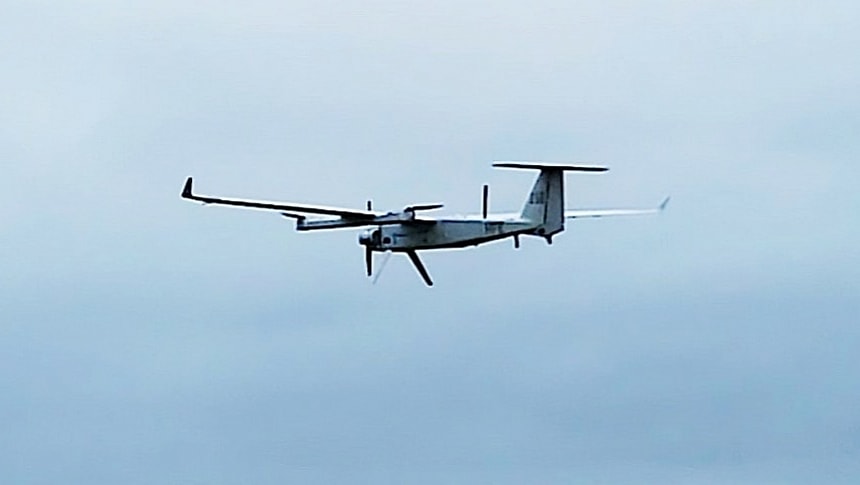When one thinks of a vertical take-off and landing (VTOL) aircraft, the first thing that comes to mind is a helicopter-like contraption that can lift off from pretty much everywhere. But the various needs of their operators, especially the ones in the military, have created stranger VTOL contraptions as well.
The Jump 20 is one such contraption. The work of defense contractor AeroVironment, it is meant to be used for intelligence, surveillance, and reconnaissance (ISR) missions. It is a VTOL, but at the same time a fixed-wing aircraft.
The drone is part of the U.S. Army’s Future Tactical Unmanned Aircraft System (FTUAS) program, which is basically a search for a replacement for the two-decade-old RQ-7B Shadow used by Brigade Combat Teams (BCT). That piece of hardware has become quite outdated not in small part because of the fact it needs a vehicle-mounted catapult to launch and arresting gear to be recovered.
In its normal configuration, meaning when equipped with a 190cc Mogas engine, the Jump 20 can stay airborne for over 13 hours, during which time it can cover distances as large as 115 miles (185 km). Technically, if there is another command station along the way, that range can be increased dramatically thanks to the drone’s handoff capabilities.
The drone can carry an assortment of payloads to complete its mission, as long as they don’t weigh over 30 pounds (14 kg). The hardware can be ready for action in about an hour, depending on the mission profile and the configuration required.
Earlier this month AeroVironment successfully tested a heavy-fuel engine on the drone. A common choice for drones that are not powered by electricity, such a powerplant could lead to more power and less fuel consumption.
As per the defense contractor, the unspecified solution tested on the Jump 20 has been “purpose-built for uncrewed systems” and comes with an output of over 15 horsepower. It can be used with a variety of fuels (the company doesn’t say which, but that typically means anything from gasoline to Jet-A1). Most importantly, regardless of the fuel used, the amount it needs to do its thing is minimal.
The engine deployed on the drone is lighter than the traditional gasoline engine used until now, and comes with an auto-start capability that should reduce the level of operator engagement. The cherry on the cake, it should also make the drone cheaper to maintain, as the engine requires less frequent maintenance.
AeroVironment does not say when or if it will actually start making Jump 20s with the new heavy-fuel engine. The Army is supposed to say what will its next main tactical drone be sometime next year.
AeroVironment is competing for the task with four other companies, including Griffon Aerospace, Northrop Grumman, Sierra Nevada, and Textron.
The drone is part of the U.S. Army’s Future Tactical Unmanned Aircraft System (FTUAS) program, which is basically a search for a replacement for the two-decade-old RQ-7B Shadow used by Brigade Combat Teams (BCT). That piece of hardware has become quite outdated not in small part because of the fact it needs a vehicle-mounted catapult to launch and arresting gear to be recovered.
In its normal configuration, meaning when equipped with a 190cc Mogas engine, the Jump 20 can stay airborne for over 13 hours, during which time it can cover distances as large as 115 miles (185 km). Technically, if there is another command station along the way, that range can be increased dramatically thanks to the drone’s handoff capabilities.
The drone can carry an assortment of payloads to complete its mission, as long as they don’t weigh over 30 pounds (14 kg). The hardware can be ready for action in about an hour, depending on the mission profile and the configuration required.
Earlier this month AeroVironment successfully tested a heavy-fuel engine on the drone. A common choice for drones that are not powered by electricity, such a powerplant could lead to more power and less fuel consumption.
As per the defense contractor, the unspecified solution tested on the Jump 20 has been “purpose-built for uncrewed systems” and comes with an output of over 15 horsepower. It can be used with a variety of fuels (the company doesn’t say which, but that typically means anything from gasoline to Jet-A1). Most importantly, regardless of the fuel used, the amount it needs to do its thing is minimal.
The engine deployed on the drone is lighter than the traditional gasoline engine used until now, and comes with an auto-start capability that should reduce the level of operator engagement. The cherry on the cake, it should also make the drone cheaper to maintain, as the engine requires less frequent maintenance.
AeroVironment does not say when or if it will actually start making Jump 20s with the new heavy-fuel engine. The Army is supposed to say what will its next main tactical drone be sometime next year.
AeroVironment is competing for the task with four other companies, including Griffon Aerospace, Northrop Grumman, Sierra Nevada, and Textron.









